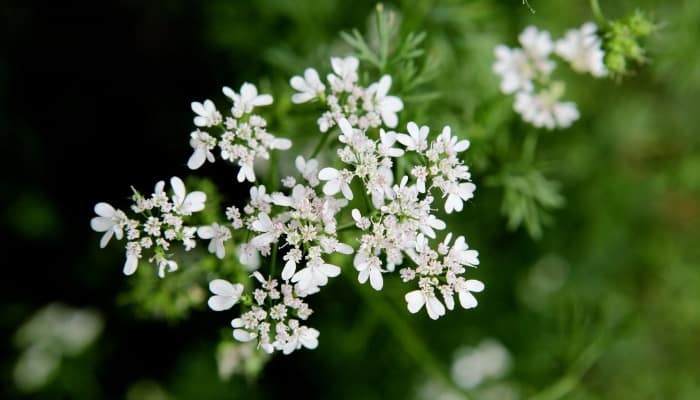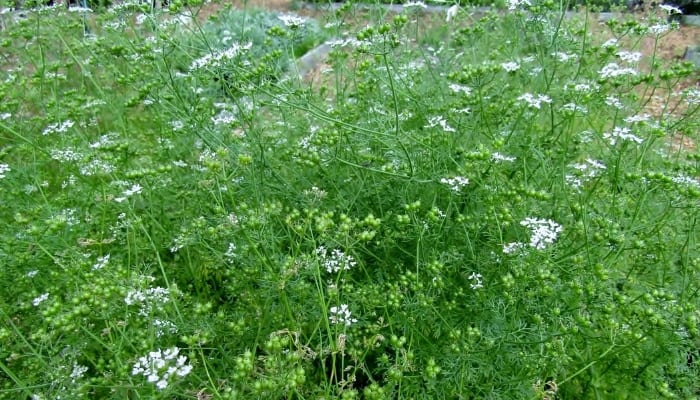Cilantro is a resilient herb that bears a slight resemblance to flattened parsley. It is cultivated in gardens all over the globe and is relatively simple to care for throughout its growth period.
What does it mean when cilantro bolts? When cilantro bolts, it is a signal that the plant is coming to the end of its life cycle. Bolting is what occurs when cilantro begins to flower and create coriander seeds. If the weather is agreeable, you may pinch the first bolts off and force the plant to keep producing new cilantro leaves.
Read on below to learn all about cilantro bolting, what causes it, and how to prolong your cilantro herb production!
Cilantro Bolting – What To Know
At the end of the growing season, flowering herbs like cilantro do something called bolting. When bolting occurs, blooms appear, stacked vertically along the main stems of the plant.
The flowers are called bolts. They grow into fully mature seeds that can be used for culinary uses or planting in the future.
If you aren’t ready for your cilantro plants to go to seed when they start bolting, simply pluck the bolts off. The bolts will try to grow back, along with additional leaves and plant matter.
In the sections below, we discuss all the nitty gritty details about cilantro bolting, why it happens, how to stop it, and more:
What Does Bolting Cilantro Look Like?
The first visual indicator that your cilantro is about to start bolting is when its main stem begins thickening.
Once the central stalk has fattened, it’s strong enough and ready to start producing tiny leaves and little white flowers.
If your cilantro is not already tall, it will also shoot up to at least 24 inches tall when bolting occurs.
What Causes Cilantro To Bolt?
Bolting is a result of cilantro’s genetics. The plant thrives in cool weather, like spring, early summer, and fall.
When the environment begins to heat up, whether it is summertime or simply a heatwave, your cilantro’s genes kick in.
When the plant senses a marked increase in temperatures it bolts as a means of survival.
Because cilantro plants know they will die once the heat sets in, they begin bolting and creating seeds to continue their existence next growing season.
Can Bolting Be Stopped?
Cilantro bolting is easily stopped, at least for a time. All you need to do is catch it within a few days of bolting and pinch the bolts off.
After you remove the initial bolts, the plants will continue to bolt if it is hot outside. If it is cool, the bolts won’t grow back as quickly.
As additional bolts attempt to grow back in, keep pinching them off until you’re ready for the cilantro to turn to seed.
Can You Eat Cilantro After It Has Bolted?
Cilantro can be eaten raw in dishes like salsa, but it can also be used dried as a cooking spice or dry ingredient.
After cilantro has bolted, you can still grow it, pick it, and dry it, but it won’t taste as potent.
Once cilantro bolts, it starts to lose much of its essential oils and flavor. It is still edible after bolting; it just doesn’t taste as good (or takes more for the same effect as unbolted cilantro in a recipe).
Cilantro Growth Stages
Cilantro plants started from seed begin as seedlings and develop into larger herbs that have a large central stem that produces branches with sets of leaves. These leaves are harvested and dried or eaten fresh.
After cilantro plants produce an abundance of leaves and the weather begins to warm up outside, they start to bolt.
Whether or not you pinch off the bolts determines how much longer the plants produce more cilantro leaves.
In most cases, once cilantro plants begin bolting, they are done growing within a couple of short weeks.
In the spring, cilantro plants grow for up to 2 months before bolting. Summer cilantro plants, on the other hand, grow for just 1 to 1 1/2 months before bolting.
Plants planted in the early fall will grow nicely until the first hard frost.
Signs That Cilantro Is Going To Bolt
When the central stem of your cilantro begins to thicken, you know it is going to bolt soon. Another telltale sign is the little white flowers that begin appearing from new growth.
Additionally, if your cilantro hasn’t reached its full height yet, it will attempt to shoot upward as it begins bolting.

Bolted Cilantro = Bonus Crop!
Cilantro has one last surprise up its sleeve after bolting: a bonus crop known around the world as coriander seeds.
Cilantro, also known as coriander, dhania, and Chinese parsley, isn’t just grown for its robust leaves but also for its potent seeds as well.
Coriander seeds are used as a seasoning as well as for brining and pickling various types of food.
After your cilantro bolts, give them another 4 to 6 weeks, and they will produce a crop of mature coriander seeds for you to harvest.
Bolt-Resistant Cilantro
If you don’t want to grow coriander seeds, you can always opt for planting and growing a bolt-resistant type of cilantro to begin with. That way, you won’t have bolting issues to deal with.
There are several bolt-resistant varieties to consider:
- Slow-Bolt
- Indian Summer
- Santos
- Leisure
- Rau Ram
- Jantar
Growing Cilantro Indoors
Cilantro is an ideal plant for growing indoors as it enjoys cooler temperatures and less sun than many herbs do.
The best place for growing cilantro indoors is in a window that receives 6 hours of sun per day.
Otherwise, it’s best to provide additional lighting (like this smart, full-spectrum bulb) for indoor cilantro plants.
Indoor cilantro does best in pots with drainage holes and consistently moist soil (not soggy but far from dry soil).
Keep your indoor cilantro in a temperature range between 50 and 80 degrees Fahrenheit for best results.
When To Plant Cilantro
There are two main times to plant cilantro: in the spring and fall. When you plant cilantro in the spring, your herb grows for up to 2 months (or slightly longer) until the temperatures really heat up.
If you live in an area with long, mild autumn weather, early fall is a great time to plant.
Tips To Delay Cilantro Bolting
If you wish to delay your cilantro from bolting, try a few of these helpful tips:
- Plant your cilantro somewhere with extra shade.
- Allow plenty of airflow to your plants.
- Add mulch around the base of your cilantro plants to cool the ground.
- Direct sow seeds rather than planting seedlings.
- Pinch the tops of your cilantro plants off as soon as bolting begins.
- Keep your plants well watered and fertilized.
- Grow bolt-resistant cilantro species.
Harvesting Cilantro
Harvesting cilantro is straightforward:
- Select leaves that are at least 4 inches in length or longer.
- Cut the leaves off where the branches connect to the main stem.
- Once you collect a handful, use a rubberband or string to tie them up in bunches and hang them to dry (or place them in containers for refrigerating/eating raw).
- Alternatively, you may cut the entire cilantro plant down just 1 to 2 inches from where the stalk is growing out of the soil.
Related Questions:
Are Cilantro Flowers Poisonous?
Cilantro flowers are not poisonous or harmful in any other way (with the exception of those who have allergy-related issues with cilantro flowers).
The flowers of cilantro plants may be eaten raw or dried and otherwise handled without issues.
How Long Does Cilantro Take To Grow?
From the time of seeding, cilantro plants take between 45 and 75 days to grow fully. The biggest determining factor for how long it takes to grow is what time of year you plant it.
Cilantro in the spring grows for longer (and produces more cilantro) than cilantro planted in the summer due to the temperature difference. Likewise, fall plantings will produce longer than summer plants.
Conclusion
Cilantro bolting isn’t the end of the world, though it is a sure sign that your cilantro’s growing season is rapidly coming to an abrupt end.
You can, however, extend your plant’s cilantro production by another week or two if you nip the bolts in the bud, literally pinching them and removing them from the plant.
Once you’ve harvested all the cilantro you want or need for the year, the bolts eventually produce a crop of coriander seeds.

